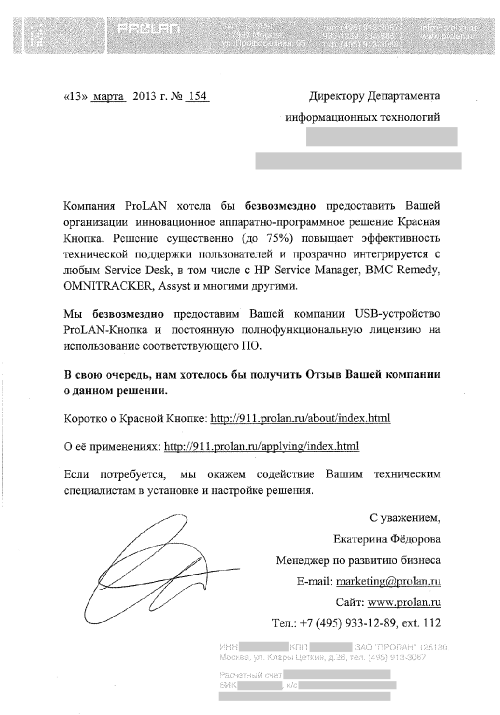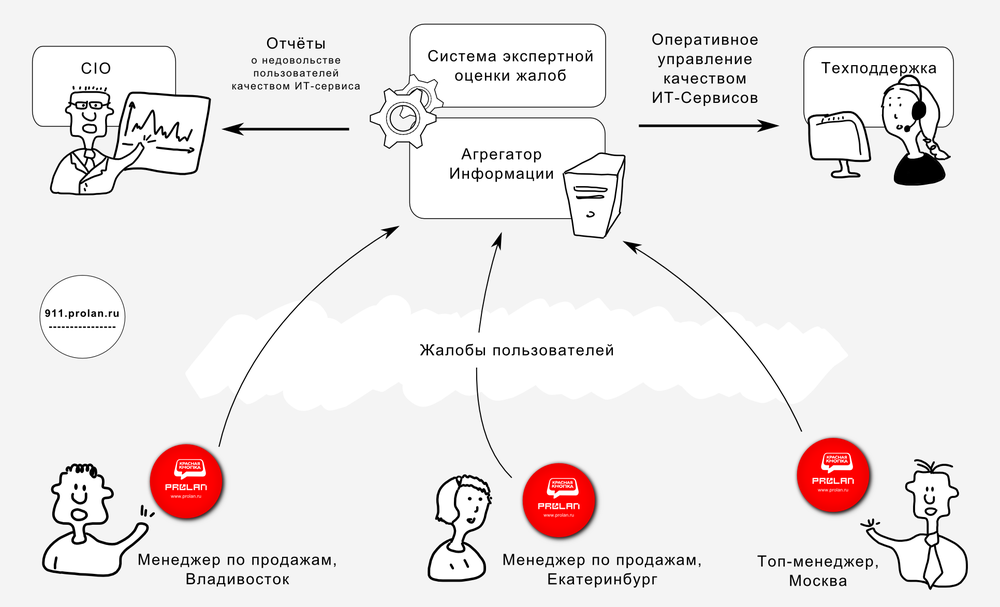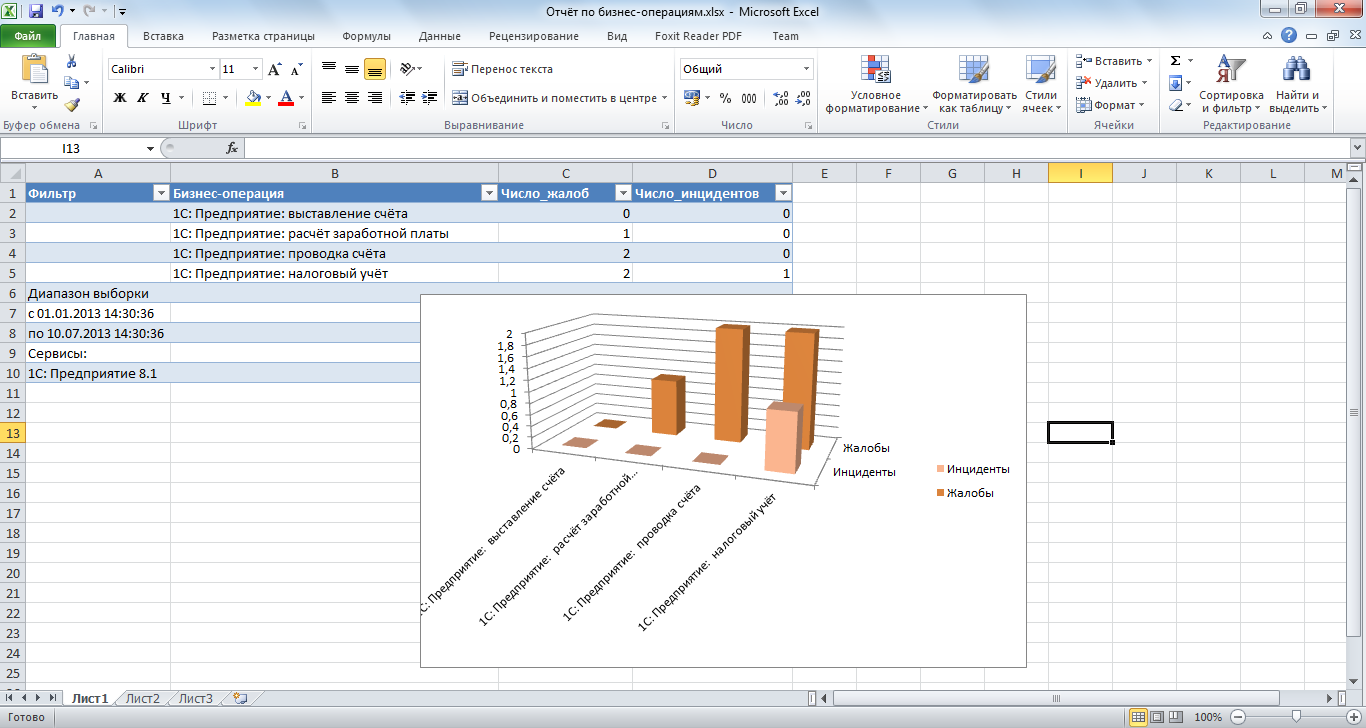Evaluation of user satisfaction as a way to find customers

At an IT services forum, one outsourcer asked which advertising concept was best for his business - publications in thematic publications, leaflet distribution, SEO, contextual advertising or telemarketing. The answers were trivial: the main thing is recommendations, advertising gives nothing, and if it does, only search engine optimization (SEO).
In this discussion I was interested in two points (besides the statement that advertising does not give anything, but this is not about that now). First, neither the top-starter, nor the participants in the discussion did not even mention such marketing communication as direct mail. Probably because they do not see the difference between direct mail and spam. Second: my attempt to convey to the participants in the discussion that the concept of advertising is not so much a way of conveying information to the target audience as the content of the advertising proposal ended in complete failure.
Upon reflection, I decided that these issues deserve not scattered comments, but a separate article. I will try not to go deep into the jungle of theorizing, but to show with concrete examples how to look for clients in the field of providing IT services using direct mail and an original advertising offer with respect to content.
Form: Can direct mail be effective?

Simplifying, we can say that the search for a client is the solution of two tasks:
- think of how to interest the client;
- bring this information to the decision maker.
The fact that spam is bad, and most importantly - ineffective, everyone knows. It is not clear what companies are counting on several times a day, offering by e-mail, fax and telephone to take over the network for maintenance, dismiss the sysadmin and, at the same time, the chief accountant. Personally, I delete such messages, even in those cases where the proposal is objectively interesting to me. Perhaps someone reacts differently. Do you know such people? Me not.
')
What is so annoying in these sentences? What offer comes mostly by e-mail? I do not think. It’s not annoying letters with an offer to get a ticket to the exhibition for free or to take part in a webinar. On the other hand, a lot of unwanted information comes through other channels, for example, regular phone calls and faxes with the same offers. What you did not subscribe to receive this information? Perhaps, but not always. It is unlikely that anyone will be annoyed by getting a witty joke on a hot topic. In my opinion, the content and form of messages are annoying. Content - buy, buy, buy . The form is an anonymous letter with a clumsy telephone number (where instead of the number “4” is the letter “H” or after each digit of a dot) and grammatical errors.
Direct mail is also an advertising message, but between direct mail and spam, as they say in Odessa, there are two big differences. Consider this on a specific example from our experience.
Some time ago, we sent the following proposal to the CIO contact database obtained from open sources. The letter was sent by fax using letterhead, indicating the outgoing number and signature of the manager. Email was used if there were direct CIO addresses. Direct mail can also be sent via ordinary mail and in general by any means that implies direct written communication between the sender and the recipient. The letter was the following (I quote it in full).
“Dear <Middle name>!
ProLAN would like to donate to your organization an innovative hardware and software solution Red Button. The solution significantly (up to 75%) increases the efficiency of technical support for users and seamlessly integrates with any Service Desk, including HP Service Manager, BMC Remedy, OMNITRACKER, Assyst and many others.
We will donate your company a ProLAN-Button USB device and a permanent full-featured license to use the appropriate software.
In turn, we would like to receive Feedback from your company on this decision.
Briefly about the Red Button: http://911.prolan.ru/about/index.html .
About its applications: http://911.prolan.ru/applying/main.html .
If necessary, we will assist your technicians in installing and configuring the solution.
Respectfully,
Full name
Contacts".

As a result, about 7% of recipients responded to the letter, mainly the heads of technical support for large companies. Probably, our letter was sent to them by the CIO. As a result, we received dozens of potential customers, of which about 10% have already become real. Effectively? Draw your own conclusions.
In my opinion, in order for direct mail to be successful, it must meet the following requirements, both in form and in content.
Requirements for direct mail content:
- Free - it should be an offer to get something for free (and not buy something). No veiled sales, commissions and fees - everything should be free indeed.
- Usefulness, originality, exclusivity - what you offer should be useful and original at the same time, and at the same time getting it without your participation should not be easy.
- Accessibility - this should not require the addressee of any costs or significant efforts that devalue the free offer.
- Transparency - from the proposal it should be clear why you are offering it (what are your motives).
Requirements for direct mail in the form:
- Razor - obtrusiveness should be avoided, so sending out should be done once, not every week / day / hour / minute.
- Means of delivery - if the distribution is done to large companies, it is desirable to use fax and regular mail, because in large companies there is a regulation on what to do with such offers, so it is likely to reach the addressee.
- Addressing and openness - the mailing should be address and the letter must contain the sender’s contacts (no anonymous letters). The letter must be assigned an outgoing number.
- Brevity - the sentence should be short.
Content: User satisfaction score

What can be offered to the addressee so that he not only reads your letter / message / fax, but also becomes your client? One of the possible options for IT outsourcers and IT service providers is to offer a free assessment of the satisfaction of users of IT services.
A proposal addressed to the first person of a small company might look something like this:
“Dear <Middle name>!
We offer gratuitously to conduct in your organization an assessment of user satisfaction with the quality of IT services that are critical for your business. The resulting report will document the level of IT services received and, thus, will reduce the potential risks associated with failures in IT Infrastructure and business applications.
To assess user satisfaction, a unique technology will be used, which allows to obtain objective information, almost without distracting personnel. You can learn more about this on our website [link to your website].
By accepting this offer, you undertake absolutely no obligations. When making this offer, we want to introduce you to our company (<Your company name>), whose main activity is IT infrastructure maintenance and business application support.
Respectfully,
Full name
Contacts"
Here are a few reasons why a proposal of this kind can be useful and successful.
| one. | Utility (for the client) and originality | Assessing user satisfaction is not a ritual offering of corporate gifts to business partners, but a way to understand how users of the IT service actually relate to it. If you are unhappy, assess the scale of the disaster and find out exactly what caused the discontent. On the other hand, such services are still rare, and it is not easy to carry out the necessary actions yourself. |
| 2 | Availability | Conducting an assessment of the satisfaction of users of an IT service does not require a serious cost and effort from a potential client. From the user's point of view, everything is very simple - when the IT service slows down, press the “red button”, and all the necessary information will automatically go to the IT service. |
| 3 | Efficiency | QuTester Plus from ProLAN, which includes all the necessary tools, is free, which means that your costs for organizing user satisfaction assessments will be minimized. Within 30 days all the functionality of the package will be available, in most cases this is enough. After 30 days there will be restrictions, but the remaining functionality for a small IT infrastructure is quite sufficient. |
| four. | Image benefits | By offering a customer-oriented service, you are also positioning yourself as a company for which customer satisfaction is not an empty sound. |
| five. | Direct contacts with decision makers | One of the most important benefits. Offers of this kind are usually addressed to the first person of the company, which means that you will receive contacts of the decision makers - those who are dissatisfied with the work of their IT service or contracting organization. (Those who are doing well are not likely to respond). |
| 6 | Objective information on the status of the potential client | The technology of the Assessment is as follows: in the process of its implementation you will receive an objective picture of the situation of the potential client, including the “who is to blame” and the scale of the disaster. Having such information, you will be able to reasonably offer clients a solution to the existing problems - to replace the server, upgrade the SCS, etc. |
| 7 | The beginning of a big way | Evaluation of user satisfaction is the first stage of an audit of the quality of IT services . |
Technology: IT Services Quality Button

What is the assessment of user satisfaction with the quality of IT services in practice?
Note. The technology of monitoring user satisfaction has already been discussed in detail in our articles “Monitoring the quality of IT services without using GUI robots and RUM” and “Health metrics of IT infrastructure, threshold values and users of IT services” , so here I will only note the most basic points.
At the core of the IT Service Quality Button concept is the automated creation and sending of user complaints. When the user notices that the IT service is working worse than we would like, he presses a special key combination - the “red button”. A special agent installed on the user's computer or terminal server collects context-sensitive information about the problem, user, computer, business application and business operation and sends a HelpMe message - a special SOAP-package with all the information collected.
HelpMe message is received by the Monitoring System Information Aggregator and recorded in the consolidated database. There, complaints are grouped according to the features of interest to us - geography, divisions, positions, IT services, etc. - and are monitored by the monitoring system along with the health metrics of the IT infrastructure and the performance of business applications.
Note. In addition to complaints, the monitoring system takes into account incidents - reports of a critical deterioration in the quality of IT services received by the technical support service.
Each metric is automatically evaluated on a five-point scale: “good”, “acceptable”, “needs attention”, “on the verge”, “bad”. For example, no more than 2 complaints per day (or per hour, or per minute) from Sochi to SAP work are “good,” more than 2 are “permissible”, more than 3 are “need attention”, etc. The dynamics of metrics, which means user satisfaction, can be seen in real time. Green squares - “good”, flashing green - “acceptable”, yellow appeared - “needs attention”.
The results of user satisfaction assessments are provided in the form of reports. Reports are uploaded as xml files that can be opened and edited in Excel. The leftmost column lists the filters used to generate the report.
Business Transaction Report

Service Report

User Report

User Group Report

findings
1. It is necessary to distinguish spam and direct mail. Direct mail is a direct written appeal to a potential client (whether by ordinary mail, e-mail or fax), compiled in accordance with a number of conditions to the form and content. Subject to these conditions, direct mail is an effective marketing communication.
2. The advertising concept is not only marketing communication, but also the content of the advertising offer. Therefore, in advertising, including IT services, you should pay as much attention to the content as to the content of the offer. The content of the proposal must meet a number of conditions: usefulness, originality, free of charge, etc.
3. In the IT services market, a non-standard and effective move can be made by a proposal to assess user satisfaction with the quality of IT services. By offering this service free of charge (for promotional purposes), you combine the free of charge service with the actual utility for the client. Evaluating user satisfaction is not a ritual presentation of corporate gifts to business partners, but a way to understand how IT service users actually relate to it. If you are unhappy, assess the scale of the disaster and find out exactly what caused the discontent. As a technical tool for the Assessment, a ProLAN solution can be used: IT services quality button .
Post Scriptum
The effectiveness of the campaign will be significantly higher if the first person (DM) of a potential client is installed a physical Red Button (ProLAN-USB Button). D-Link partners (and those who want to become them) can get such a device for free at any D-Link office. More on this .
Source: https://habr.com/ru/post/186834/
All Articles